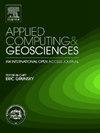A new inversion algorithm (PyMDS) based on the Pyro library to use chlorine 36 data as a paleoseismological tool on normal fault scarps
IF 3.2
Q2 COMPUTER SCIENCE, INTERDISCIPLINARY APPLICATIONS
引用次数: 0
Abstract
Paleoseismology (study of earthquakes that occurred before records were kept and before instruments can record them) provides useful information such as recurrence periods and slip rate to assess seismic hazard and better understand fault mechanisms. Chlorine 36 is one of the paleoseismological tools that can be used to date scarp exhumation associated with earthquakes events.
We propose an algorithm, PyMDS, that uses chlorine 36 data sampled on a fault scarp to retrieve seismic sequences (age and slip associated to each earthquake) and long term slip rate on a normal fault.
We show that the algorithm, based on Hamiltonian kernels, can successfully retrieve earthquakes and long term slip rate on a synthetic dataset. The precision on the ages can vary between few thousand years for old earthquakes (>5000 yr BP) and down to few hundreds of years for the most recent ones (<2000 yr BP). The resolution on the slip is ∼30–50 cm and on the slip rate is ∼ 1 mm/yr. Diagnostic tools (Rhat and divergences on chains) are used to check the convergence of the results.
Our new code is applied to a site in Central Italy, the results yielded are in agreement with the ones obtained previously with another inversion procedure. We found 4 events 7800±400 yr, 4700±400 yr, 3000±200 and 400 ±20 yr BP on the MA3 site. The associated slips were of 130±10 cm, 140±20 cm, 580 ± 20 cm and 205±20 cm. The results are comparable with a previous study made by (Schlagenhauf et al., 2010). The yielded slip rate of 2.7 mm/yr ± 0.4 mm/yr is also coherent with the one determined by Tesson et al. (2020).
基于Pyro库的氯36古地震反演算法(PyMDS)
古地震学(研究在有记录和仪器记录之前发生的地震)提供了有用的信息,如复发周期和滑动率,以评估地震危害并更好地了解断层机制。氯36是一种古地震学工具,可用于确定与地震事件有关的陡崖发掘的年代。我们提出了一种算法PyMDS,该算法使用断层崖上采样的氯36数据来检索正常断层的地震序列(与每次地震相关的年龄和滑动)和长期滑动率。我们表明,该算法基于哈密顿核,可以成功地检索合成数据集上的地震和长期滑动率。年龄的精确度可以从几千年的老地震(距今5000年)到几百年的最近地震(距今2000年)不等。滑移的分辨率为~ 30-50 cm,滑移速率为~ 1 mm/yr。诊断工具(Rhat和链上的散度)用于检查结果的收敛性。我们的新代码应用于意大利中部的一个站点,所得结果与以前使用另一种反演程序获得的结果一致。我们在MA3位点发现了4个事件(7800±400 yr, 4700±400 yr, 3000±200和400±20 yr)。相关滑移分别为130±10 cm、140±20 cm、580±20 cm和205±20 cm。该结果与(Schlagenhauf et al., 2010)先前的研究结果相当。产生的滑移率为2.7 mm/yr±0.4 mm/yr,也与Tesson等人(2020)确定的滑移率一致。
本文章由计算机程序翻译,如有差异,请以英文原文为准。
求助全文
约1分钟内获得全文
求助全文
来源期刊

Applied Computing and Geosciences
Computer Science-General Computer Science
CiteScore
5.50
自引率
0.00%
发文量
23
审稿时长
5 weeks
 求助内容:
求助内容: 应助结果提醒方式:
应助结果提醒方式:


